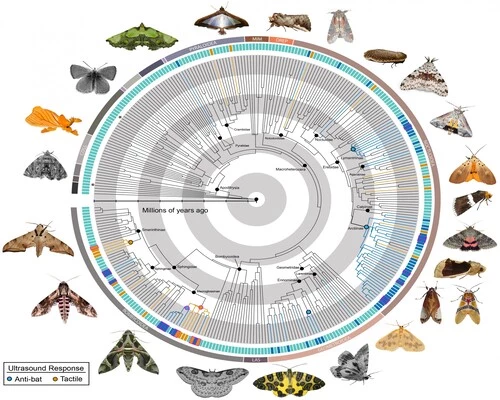A new study finds that ultrasound-producing moths are much more common than previously thought, with three new sound-producing organs, eight new subfamilies, and potentially thousands of species added to the list.
While a clear night sky may appear to us to be quiet and peaceful, devoid of all but stars, this nocturnal world is filled with a high-pitched cacophony of sound just beyond our ability to hear. Bats use ultrasonic pulses to pierce the shadows, allowing them to create an auditory map of their surroundings, which is bad news for moths, one of their favorite foods.
Not all moths, however, are defenseless prey. Some emit ultrasonic signals of their own, causing bats to flee. Many moths with bitter toxins avoid capture entirely by emitting distinct ultrasounds that alert bats to their foul taste. Others hide behind a cloak of sonar-jamming static, making them difficult to locate using bat echolocation.
While effective, auditory defense mechanisms in moths are relatively uncommon, with only tiger moths, hawk moths, and a single species of geometrid moth known. However, a new study published in the journal PNAS shows that ultrasound-producing moths are far more common than previously thought, with three newly discovered sound-producing organs, eight new subfamilies, and potentially thousands of species added to the list.
Moths and butterflies are one of the most diverse groups on the planet, accounting for one out of every ten named animals. If these findings hold true, it will most likely be the world’s largest collection of mimicry complexes.
Akito Kawahara
“It’s not just tiger moths and hawk moths that are doing this. There are tons of moths that create ultrasonic sounds, and we hardly know anything about them,” said senior author Akito Kawahara, a curator at the Florida Museum of Natural History’s McGuire Center for Lepidoptera & Biodiversity.
The researchers were also curious about how these sounds might converge between moth species. In the same way that non-toxic butterflies mimic the colors and wing patterns of less desirable relatives, moths that lack the benefit of built-in toxins can mimic the pitch and timbre of truly repulsive relatives.
After collecting and studying thousands of moths in Ecuador, French Guiana, Mozambique, and Malaysian Borneo for over a decade, the researchers spent a final two weeks in Ecuador recording the alarm calls of every moth they could catch. Following that, they used a theoretical physicist and a machine learning algorithm to examine each note for similarities.

The program confirmed what previous researchers had only hypothesized: moth species do not behave like individual composers, each with their own distinct calling card and style. Instead, a small number of moths generate their own scores, which appear to be replicated by other moths in complex acoustic mimicry rings.
More research is needed, according to lead author Jesse Barber, a biology professor at Boise State University, to determine the exact nature of these sounds, but he suspects the trailblazing moths at the center of these rings are noxious, while the copycats on the outskirts are merely false advertisers.
“Moths and butterflies are one of the most diverse groups on the planet, accounting for one out of every ten named animals. If these findings hold true, it will most likely be the world’s largest collection of mimicry complexes” He stated.
These ultrasonic warning systems appear to be so useful in avoiding bats that they have evolved independently in moths on multiple occasions. Moths transformed different parts of their bodies into finely tuned organic instruments in each case.
“Tiger moths have tymbals that buckle inward and outward,” Kawahara explained. “Some of them have structures on their wings, others have structures on their abdomens, and still others have modified genitals!”
Several of the various clickers and scrapers moths use as a bat repellant are described in this study for the first time. This includes a species of calpine moth that rubs together overlapping abdominal scales, similar to the way crickets make their characteristic chirping sounds. Another species, in a group called the snout moths, makes noise by using a structure resembling a guitar pick between its wings, which is strummed against when the moth is in flight.
Anti-bat signaling is not limited to moths. By beating their wings against their protective casings, some tiger beetles can produce defensive clicks at bats. Other insect groups, such as katydids, crickets, and mantids, can hear incoming bats, and Barber speculates that some may be able to communicate with their pursuers. However, with roughly 40% of insect species currently on the verge of extinction, at a rate that outpaces researchers’ ability to discover and name them, he warns of the very real possibility that this ultrasonic symphony will cease to exist before we have a chance to hear it or learn what it means.
“These mimicry complexes are most likely not limited to moths,” he explained. “The entire tapestry of nocturnal insect life is most likely involved, but the opportunity to understand the natural world is fading. So many lineages are becoming extinct that we are most likely living in the final golden age of biology. If we do it now, we can still understand how life unfolded.”
















